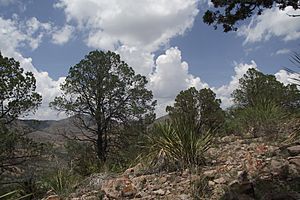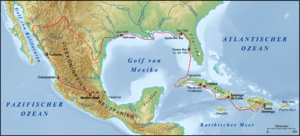Texas pinyon facts for kids
Quick facts for kids Texas pinyon |
|
|---|---|
 |
|
| Pinus remota located in the Mexican state of Chihuahua near the Big Bend of Texas. | |
| Conservation status | |
| Scientific classification |
The Texas pinyon or papershell pinyon (scientific name: Pinus remota) is a type of pine tree. It belongs to a group of pines called pinyon pines. You can find this tree growing naturally in southwestern Texas and northeastern Mexico.
This pinyon is special because its seeds have very thin shells. This made them a popular food for Indigenous peoples and Mexicans who lived where the trees grew. In 1536, the Spanish explorer Cabeza de Vaca even wrote about how important these pine nuts were as a food source.
Contents
What Does the Texas Pinyon Look Like?
The Texas pinyon is usually a small tree or a large shrub. It can grow to be about 3 to 10 meters (10 to 33 feet) tall. Its trunk can be up to 40 centimeters (16 inches) wide. The bark on the tree is thick, rough, and scaly.
Leaves and Cones
The leaves of the Texas pinyon are called 'needles'. They are thin and grow in groups of two or three, but mostly in pairs. Each needle is about 3 to 5 centimeters (1 to 2 inches) long. They have a dull gray-green color.
The cones are round and squat. When closed, they are about 3 to 5 centimeters (1 to 2 inches) long and wide. They start green and turn yellow-buff after about 18 to 20 months. These cones have only a few thin scales, usually 5 to 12 fertile ones.
Seeds and How They Spread
When the cones are ripe, they open up to 4 to 6 centimeters (1.5 to 2.4 inches) wide. The seeds stay on the scales even after the cone opens. These seeds are 10 to 12 millimeters (about half an inch) long. They have a very thin shell and a white inside called an endosperm. They also have a tiny, leftover wing that is only 1 to 2 millimeters long.
Woodhouse's scrub jays help spread these seeds. The jays pull the seeds out of the open cones to eat them. They also store many seeds for later use. Some of these stored seeds are never eaten and can grow into new Texas pinyon trees.
How Scientists Classified This Tree
For a long time, the Texas pinyon was thought to be part of the Mexican pinyon species. But in 1966, a US botanist named Elbert L. Little noticed something different. He saw that some pinyon seeds in Texas had very thin shells, unlike most others.
He first called it a variety of the Mexican pinyon. Later research showed more differences. Now, scientists usually consider it a separate species. It might even be more closely related to the Colorado pinyon (P. edulis). Both the Texas pinyon and Colorado pinyon have thin seed shells and needles mostly in pairs. The Texas pinyon is unique because its cone scales have a very small, sunken bump, which is different from other pinyons.
Where the Texas Pinyon Grows
The Texas pinyon grows in western Texas, United States. You can find it on the southern edge of the Edwards Plateau. It also grows in the hills between Fort Stockton and Presidio. In northeastern Mexico, it is mainly found in Coahuila. It also grows a little bit in Chihuahua and Nuevo León.
This tree grows at low to medium heights. In the Edwards Plateau, it is found from 450 to 700 meters (1,475 to 2,300 feet) high. In other areas, it grows from 1200 to 1800 meters (3,900 to 5,900 feet) high. It is not very common and grows in small, spread-out groups. These trees usually live in dry, rocky places and in arroyos (dry creek beds). The bare rock in these areas helps stop wildfires from spreading easily.
Uses of the Texas Pinyon
People sometimes collect the edible seeds of the Texas pinyon. They are sold as pine nuts, just like seeds from other pinyon trees. However, this tree grows in very dry places. Because of this, it does not produce many seeds very often. This makes it less valuable for collecting seeds.
Sometimes, the Texas pinyon is planted as an ornamental tree. This means it is grown for its beauty. It can handle very dry conditions and even semi-desert areas. This makes it a good choice for planting in hot, dry places.
The Papershell Pinyon and Cabeza de Vaca's Journey
The Pinus remota tree is important for figuring out the path of Spanish explorer Álvar Núñez Cabeza de Vaca. He was the first European to explore Texas and the northern part of Mexico. In 1535, Cabeza de Vaca wrote about his travels. He said that the Indigenous peoples he met gave him and his friends pine nuts to eat. He described them as "better than those of Castile [Spain], because they have very thin shells."
Debating the Route
For a long time, scholars tried to map Cabeza de Vaca's journey. He traveled from near Galveston, Texas on the Gulf of Mexico to the Pacific Ocean coast of Mexico. In 1940, a scholar named Cleve Hallenbeck thought Cabeza de Vaca was talking about the seeds of the Colorado pinyon (Pinus edulis). This tree grows in the mountains of southern New Mexico and nearby Texas. However, it does not grow in northeastern Mexico. The Mexican pinyon (Pinus cembroides) found in Mexico has thick shells, not thin ones. So, Hallenbeck believed Cabeza de Vaca must have traveled across Texas. He thought he crossed the Rio Grande river near El Paso, Texas.
But in 1961, Alex D. Krieger suggested a different route. He thought Cabeza de Vaca traveled along the Texas coast. Then, he crossed the Rio Grande into Mexico. From there, he turned northwest, passing near modern-day Monclova, Mexico. He would then have continued through Mexico to meet the Rio Grande again near modern-day Presidio, Texas. People who supported the Texas-only route did not believe Krieger's idea. This was because no pinyon with thin-shelled seeds was known to grow in northern Mexico at that time.
A New Discovery Changes Everything
However, in 1966, the botanist Elbert L. Little described a new type of Mexican pinyon with "thin shelled seeds." Then, in 1979, scientists suggested this thin-shelled pinyon should be its own species, named Pinus remota, or the papershell pinyon.
In 1996, scholars went to the Monclova, Mexico area. They collected samples of the papershell pinyon. This proved that Cabeza de Vaca could have found thin-shelled pinyon seeds in Mexico, as well as in Texas. Because of this discovery, many scholars now support Krieger's idea of a trans-Mexico route for Cabeza de Vaca.
See also
 In Spanish: Pinus remota para niños
In Spanish: Pinus remota para niños



